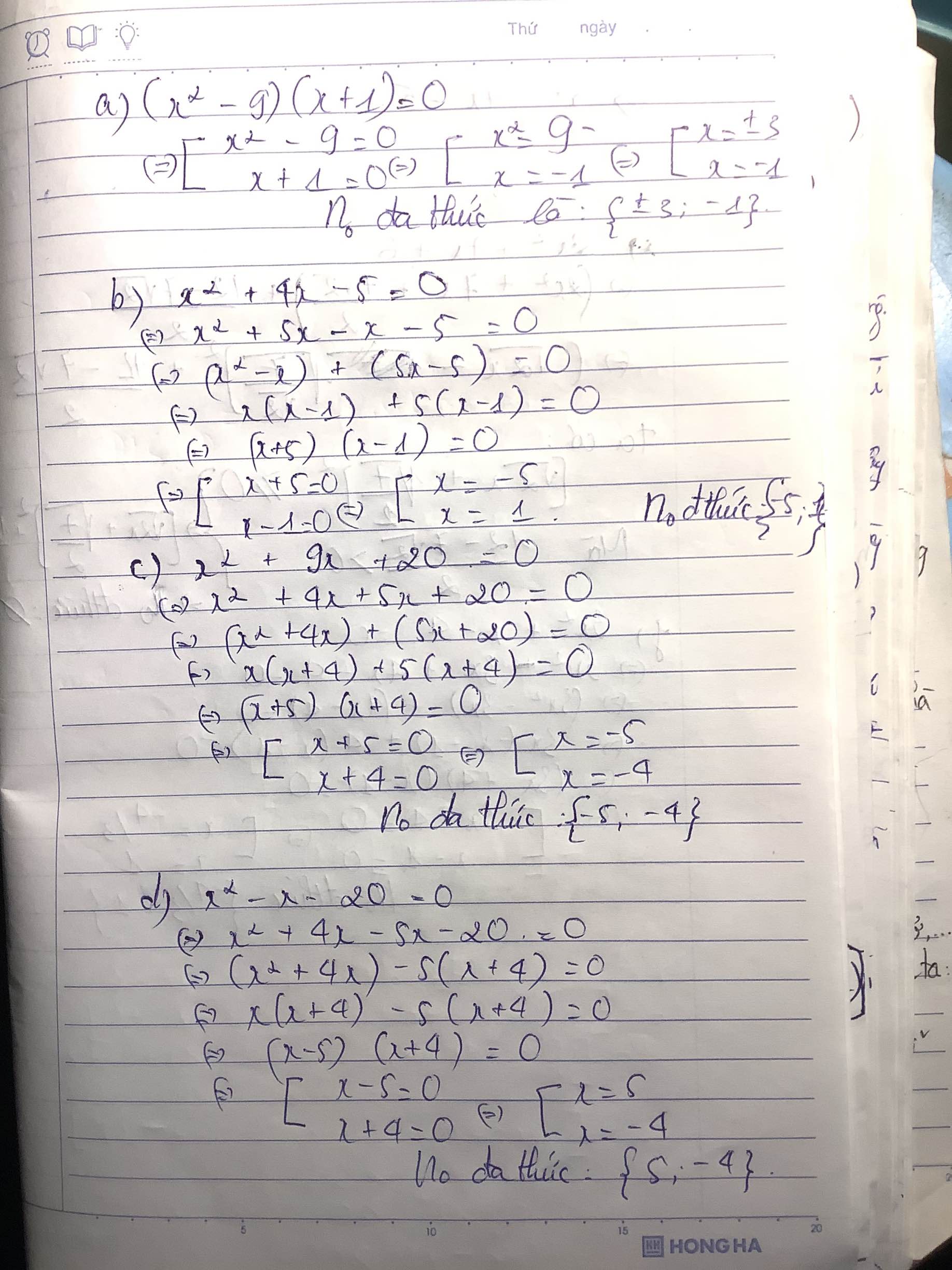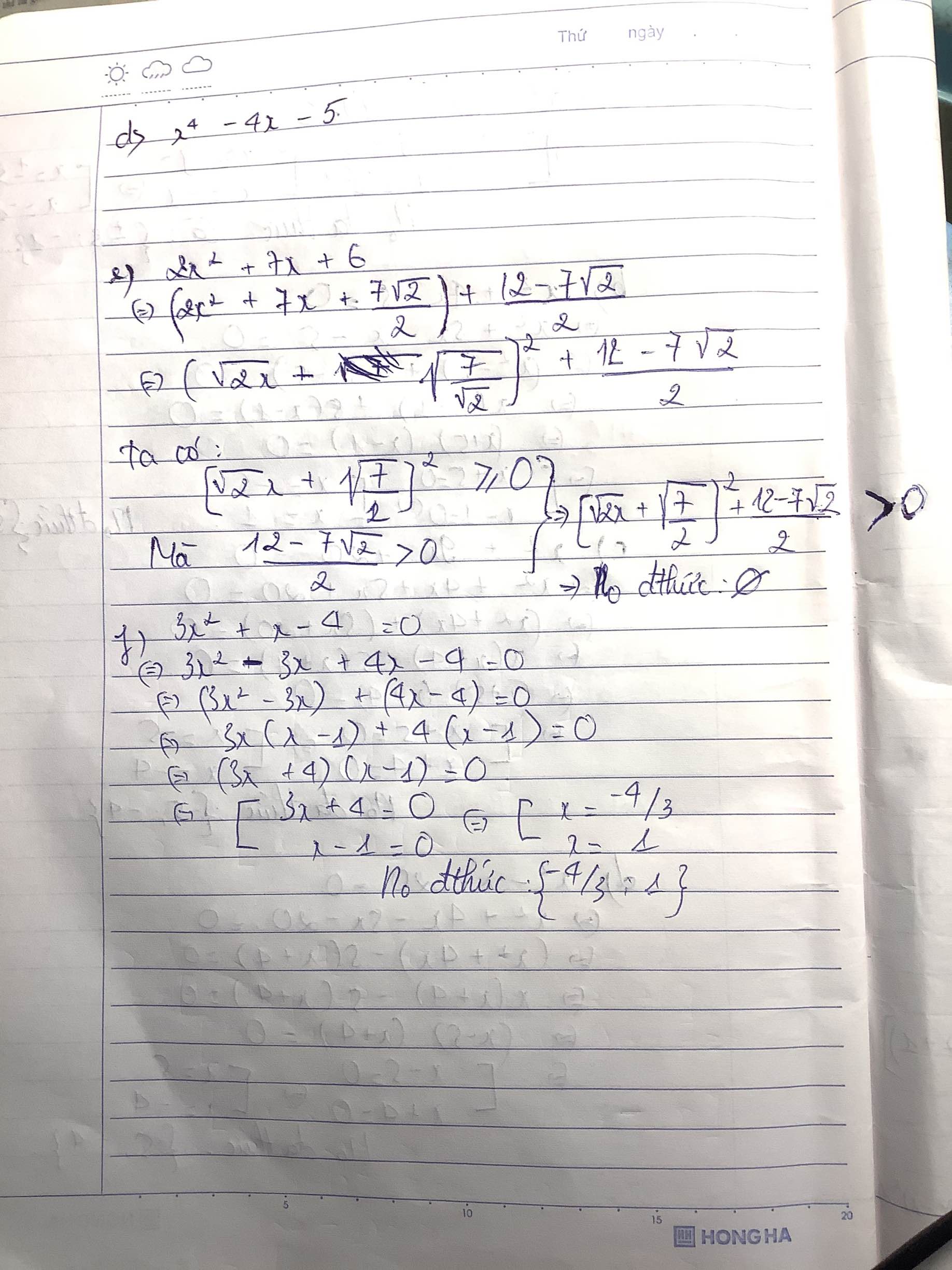Tìm nghiệm của đa thức:
a) 4x+9
b) x2 - 9
c) x2 -x
d) (x - 4)(x2 +1)
Hãy nhập câu hỏi của bạn vào đây, nếu là tài khoản VIP, bạn sẽ được ưu tiên trả lời.


a) \(\left(x-1\right)\left(x+5\right)=0\Rightarrow\left[{}\begin{matrix}x-1=0\\x+5=0\end{matrix}\right.\)\(\Leftrightarrow\left[{}\begin{matrix}x=1\\x=-5\end{matrix}\right.\)
b) \(x+1x^2+1=x^2+x+1=x^2+2.\dfrac{1}{2}x+\dfrac{1}{4}+\dfrac{3}{4}=\left(x+\dfrac{1}{2}\right)^2+\dfrac{3}{4}\ge\dfrac{3}{4}>0\)với mọi x.
=> Pt vô nghiệm.
c) \(x^2+4x=0\Leftrightarrow x\left(x+4\right)=0\Leftrightarrow\left[{}\begin{matrix}x=0\\x+4=0\end{matrix}\right.\)\(\Leftrightarrow\left[{}\begin{matrix}x=0\\x=-4\end{matrix}\right.\)
P/s: Check lại đề ý b nhé.
a) Ta có:(x-1)(x+5)=0
\(\Leftrightarrow\left[{}\begin{matrix}x-1=0\\x+5=0\end{matrix}\right.\Leftrightarrow\left[{}\begin{matrix}x=1\\x=-5\end{matrix}\right.\)
Vậy: S={1;-5}
b) Ta có: \(x^2+x+1=0\)
\(\Leftrightarrow x^2+2\cdot x\cdot\dfrac{1}{2}+\dfrac{1}{4}+\dfrac{3}{4}=0\)
\(\Leftrightarrow\left(x+\dfrac{1}{2}\right)^2+\dfrac{3}{4}=0\)(Vô lý)
Vậy: \(S=\varnothing\)
c) Ta có: \(x^2+4x=0\)
\(\Leftrightarrow x\left(x+4\right)=0\)
\(\Leftrightarrow\left[{}\begin{matrix}x=0\\x+4=0\end{matrix}\right.\Leftrightarrow\left[{}\begin{matrix}x=0\\x=-4\end{matrix}\right.\)
Vậy: S={0;-4}

Lời giải:
1.
$4x+9=0$
$4x=-9$
$x=\frac{-9}{4}$
2.
$-5x+6=0$
$-5x=-6$
$x=\frac{6}{5}$
3.
$x^2-1=0$
$x^2=1=1^2=(-1)^2$
$x=\pm 1$
4.
$x^2-9=0$
$x^2=9=3^2=(-3)^2$
$x=\pm 3$
5.
$x^2-x=0$
$x(x-1)=0$
$x=0$ hoặc $x-1=0$
$x=0$ hoặc $x=1$
6.
$x^2-2x=0$
$x(x-2)=0$
$x=0$ hoặc $x-2=0$
$x=0$ hoặc $x=2$
7.
$x^2-3x=0$
$x(x-3)=0$
$x=0$ hoặc $x-3=0$
$x=0$ hoặc $x=3$
8.
$3x^2-4x=0$
$x(3x-4)=0$
$x=0$ hoặc $3x-4=0$
$x=0$ hoặc $x=\frac{4}{3}$

\(A\left(x\right)=\left(3-4+x^2\right)^{2004}\left(3+4x+x^2\right)^{2005}\)
Đa thức `A(x)` sau khi bỏ dấu ngoặc:
\(A\left(x\right)=a_nx^n+a_{n-1}x^{n-1}+...+a_1x+a_0\)
Với `n = 2 . 2004 + 2 . 2005 = 8018`
Ta thay `x = 1` thì \(A\left(1\right)=a_n+a_{n-1}+...+a_1+a_0\)
`=> A(1)` là tổng các hệ số của `A(x)` khi bỏ dấu ngoặc
Ta có: \(A\left(1\right)=\left(3-4.1+1^2\right)^{2004}\left(3+4.1+1^2\right)^{2005}\)
\(=0^{2004}.8^{2005}=0\)
Vậy tổng các hệ số của đa thức `A(x)` nhận được sau khi bỏ dấu ngoặc là `0`

a)
⇔ \(x^2-16=9\)
⇔ \(x^2=25\)
⇔ \(x=\pm5\)
b)
⇔ \(x^2-4x+4-25x^2+20x-4=0\)
⇔ \(16x-24x^2=0\)
⇔ \(8x\left(2-3x\right)=0\)
⇒ \(\left[{}\begin{matrix}x=0\\2-3x=0\end{matrix}\right.\) ⇔ \(\left[{}\begin{matrix}x=0\\x=\dfrac{2}{3}\end{matrix}\right.\)
Vậy \(x=0\) hoặc \(x=\dfrac{2}{3}\)
c)
⇔ \(3x^2-10x-20=0\)
⇔ \(x^2-2.x.\dfrac{5}{3}+\dfrac{25}{9}-\dfrac{205}{9}=0\)
⇔ \(\left(x-\dfrac{5}{3}\right)^2=\dfrac{205}{9}\)
⇒ \(\left[{}\begin{matrix}x-\dfrac{5}{3}=\sqrt{\dfrac{205}{9}}\\x-\dfrac{5}{3}=-\sqrt{\dfrac{205}{9}}\end{matrix}\right.\) ⇔ \(\left[{}\begin{matrix}x=\dfrac{\sqrt{\text{205}}}{\text{3}}+\dfrac{5}{3}\\x=-\dfrac{\sqrt{\text{205}}}{\text{3}}+\dfrac{5}{3}\end{matrix}\right.\) ⇔ \(\left[{}\begin{matrix}x=\dfrac{15+\text{9}\sqrt{\text{205}}}{\text{9}}\\\text{x}=-\dfrac{15+\text{9}\sqrt{\text{205}}}{\text{9}}\end{matrix}\right.\)
Vậy...
d)
⇔ \(\left(x^2+x\right)^2-49=\left(x^2+x\right)^2-7x\)
⇔ 7x = 49
⇔ x=7
Vậy...

a) \(4x+9=0\Leftrightarrow4x=-9\Leftrightarrow x=-\dfrac{9}{4}\)
b) \(-5x+6=0\Leftrightarrow5x=6\Leftrightarrow x=\dfrac{6}{5}\)
c) \(x^2-1=0\Leftrightarrow\left(x-1\right)\left(x+1\right)=0\Leftrightarrow\)\(\left[{}\begin{matrix}x=1\\x=-1\end{matrix}\right.\)
d) \(x^2-9=0\Leftrightarrow\left(x-3\right)\left(x+3\right)=0\)\(\Leftrightarrow\left[{}\begin{matrix}x=3\\x=-3\end{matrix}\right.\)
e) \(x^2-x=0\Leftrightarrow x\left(x-1\right)=0\Leftrightarrow\)\(\left[{}\begin{matrix}x=0\\x=1\end{matrix}\right.\)
f) \(x^2-2x=0\Leftrightarrow x\left(x-2\right)=0\Leftrightarrow\)\(\left[{}\begin{matrix}x=0\\x=2\end{matrix}\right.\)
g) \(\left(x-4\right)\left(x^2+1\right)=0\Leftrightarrow x-4=0\Leftrightarrow x=4\)( do \(x^2+1\ge1>0\))
h) \(3x^2-4x=0\Leftrightarrow x\left(3x-4\right)=0\Leftrightarrow\)\(\Leftrightarrow\left[{}\begin{matrix}x=0\\x=\dfrac{4}{3}\end{matrix}\right.\)
i) \(x^2+9=0\Leftrightarrow x^2=-9\)( vô lý do \(x^2\ge0>-9\))
Vậy \(x\in\left\{\varnothing\right\}\)

Bài 1:
\(a,x^4+5x^2+9\\=(x^4+6x^2+9)-x^2\\=[(x^2)^2+2\cdot x^2\cdot3+3^2]-x^2\\=(x^2+3)^2-x^2\\=(x^2+3-x)(x^2+3+x)\)
\(b,x^4+3x^2+4\\=(x^4+4x^2+4)-x^2\\=[(x^2)^2+2\cdot x^2\cdot2+2^2]-x^2\\=(x^2+2)^2-x^2\\=(x^2+2-x)(x^2+2+x)\)
\(c,2x^4-x^2-1\\=2x^4-2x^2+x^2-1\\=2x^2(x^2-1)+(x^2-1)\\=(x^2-1)(2x^2+1)\\=(x-1)(x+1)(2x^2+1)\)
Bài 2:
\(a,\left(x+1\right)\left(x+2\right)\left(x+3\right)\left(x+4\right)=120\)
\(\Leftrightarrow\left[\left(x+1\right)\left(x+4\right)\right]\cdot\left[\left(x+2\right)\left(x+3\right)\right]=120\)
\(\Leftrightarrow\left(x^2+5x+4\right)\left(x^2+5x+6\right)=120\) (1)
Đặt \(x^2+5x+5=y\), khi đó (1) trở thành:
\(\left(y-1\right)\left(y+1\right)=120\)
\(\Leftrightarrow y^2-1=120\)
\(\Leftrightarrow y^2=121\)
\(\Leftrightarrow\left[{}\begin{matrix}y=11\\y=-11\end{matrix}\right.\)
+, TH1: \(y=11\Leftrightarrow x^2+5x+5=11\)
\(\Leftrightarrow x^2+5x-6=0\)
\(\Leftrightarrow x^2-x+6x-6=0\)
\(\Leftrightarrow x\left(x-1\right)+6\left(x-1\right)=0\)
\(\Leftrightarrow\left(x-1\right)\left(x+6\right)=0\)
\(\Leftrightarrow\left[{}\begin{matrix}x-1=0\\x+6=0\end{matrix}\right.\Leftrightarrow\left[{}\begin{matrix}x=1\\x=-6\end{matrix}\right.\left(\text{nhận}\right)\)
+, TH2: \(y=-11\Leftrightarrow x^2+5x+5=-11\)
\(\Leftrightarrow x^2+5x+16=0\)
\(\Leftrightarrow\left[x^2+2\cdot x\cdot\dfrac{5}{2}+\left(\dfrac{5}{2}\right)^2\right]-\dfrac{25}{4}+16=0\)
\(\Leftrightarrow\left(x+\dfrac{5}{2}\right)^2+\dfrac{39}{4}=0\)
Ta thấy: \(\left(x+\dfrac{5}{2}\right)^2\ge0\forall x\)
\(\Rightarrow\left(x+\dfrac{5}{2}\right)^2+\dfrac{39}{4}\ge\dfrac{39}{4}>0\forall x\)
Mà \(\left(x+\dfrac{5}{2}\right)^2+\dfrac{39}{4}=0\)
\(\Rightarrow\) loại
Vậy \(x\in\left\{1;-6\right\}\).
\(b,\) Đề thiếu vế phải rồi bạn.

a)
Ta có:
\(A=x^2-2x-1=x^2-2x+1-2=\left(x-1\right)^2-2\)
\(\ge0-2=-2\)
Vậy \(A_{min}=-2\), đạt được khi và chỉ khi \(x-1=0\Leftrightarrow x=1\)
b)\(B=4x^2+4x+8=4x^2+4x+1+7\)
\(=\left(2x+1\right)^2+7\ge0+7=7\)
Vậy \(B_{min}=7\), đạt được khi và chỉ khi \(2x+1=0\Leftrightarrow x=\dfrac{-1}{2}\)
c)
Ta có:
\(C=3x-x^2+2=2-\left(x^2-3x\right)\)
\(=2+\dfrac{9}{4}-\left(x^2-2x.\dfrac{3}{2}+\dfrac{9}{4}\right)\)
\(=\dfrac{17}{4}-\left(x-\dfrac{3}{2}\right)^2\le\dfrac{17}{4}-0=\dfrac{17}{4}\)
Vậy \(C_{max}=\dfrac{17}{4}\), đạt được khi và chỉ khi \(x-\dfrac{3}{2}=0\Leftrightarrow x=\dfrac{3}{2}\)
d) Ta có:
\(D=-x^2-5x=-\left(x^2+5x\right)=\dfrac{25}{4}-\left(x^2+2x.\dfrac{5}{2}+\dfrac{25}{4}\right)\)
\(=\dfrac{25}{4}-\left(x+\dfrac{5}{2}\right)^2\le\dfrac{25}{4}-0=\dfrac{25}{4}\)
Vậy \(D_{max}=\dfrac{25}{4}\), đạt được khi và chỉ khi \(x+\dfrac{5}{2}=0\Leftrightarrow x=-\dfrac{5}{2}\)
e) Ta có:
\(E=x^2-4xy+5y^2+10x-22y+28\)
\(=x^2+4y^2+5^2-4xy+10x-20y+y^2-2y+1+2\)
\(=\left(x-2y+5\right)^2+\left(y-1\right)^2+2\)
\(\ge0+0+2=2\)
Vậy \(E_{min}=2\), đạt được khi và chỉ khi \(x-2y+5=y-1=0\)
\(\Leftrightarrow\left\{{}\begin{matrix}x=-3\\y=1\end{matrix}\right.\)

cho B(x) = 0
\(=>-5x+30=0\Rightarrow-5x=-30\Rightarrow x=6\)
cho E(x) = 0
\(=>x^2-81=0\Rightarrow x^2=81=>\left[{}\begin{matrix}x=9\\x=-9\end{matrix}\right.\)
cho C(x) = 0
\(=>2x+\dfrac{1}{3}=0=>2x=-\dfrac{1}{3}=>x=-\dfrac{1}{6}\)
bạn tham khảo hai câu này nha vì mình ko biết là mấy câu còn lại
B(x)=-5x+30
cho B(x)=0
=> -5x+30=0
-5x=-30
x=-30:(-5)
x=-6
* Vậy nghiệm của đa thức B(x) là -6.
C(x)=2x+1/3
cho C(x)=0
=>2x+1/3=0
2x=-1/3
x=-1/3:2
x=-1/6
vậy nghiệm của đa thức C(x) là -1/6.


a) 4x + 9
Đa thức có nghiệm <=> 4x + 9 = 0
<=> 4x = -9
<=> x = -9/4
Vậy nghiệm của đa thức = -9/4
b) x2 - 9 = 0
Đa thức có nghiệm <=> x2 - 9 = 0
<=> x2 = 9
<=> x = 3 hoặc x = -3
Vậy nghiệm của đa thức là 3 và -3
c) x2 - x
Đa thức có nghiệm <=> x2 - x = 0
<=> x(x - 1) = 0
<=> x = 0 hoặc x = 1
Vậy nghiệm của đa thức là 0 và 1
d) (x-4)(x2+1)
Đa thức có nghiệm <=> (x-4)(x2+1) = 0
<=> x - 4 = 0 hoặc x2 + 1 = 0
* x - 4 = 0 => x = 4
* x2 + 1 = 0 => x2 = -1 ( vô lí )
<=> x = 4
Vậy nghiệm của đa thức = 4